Future Irrigation Water Requirements of the Main Crops Cultivated in the Niger River Basin
Abstract
1. Introduction
2. Materials and Methods
2.1. The Study Area
2.2. Data Source
2.3. The Net Irrigation Water Requirement Model
2.4. Climate Input
3. Results
3.1. Irrigation Water Requirement according to CSIRO
3.1.1. RCP 4.5
3.1.2. RCP 8.5
3.2. Irrigation Water Requirement according to ECHAM
3.2.1. RCP 4.5
3.2.2. RCP 8.5
3.3. Irrigation Water Requirement according to MIROC 5
3.3.1. RCP 4.5
3.3.2. RCP 8.5
4. Discussion
5. Conclusions
Author Contributions
Funding
Acknowledgments
Conflicts of Interest
References
- Piao, S.; Ciais, P.; Huang, Y.; Shen, Z.; Peng, S.; Li, J.; Zhou, L.; Liu, H.; Ma, Y.; Ding, Y.; et al. The impacts of climate change on water resources and agriculture in China. Nature 2010, 467, 43. [Google Scholar] [CrossRef]
- Rahim, S.; Xu, J.; Hameed, F.; Khalil, A.; Wei, Q.; Cai, S.; Wenhuan, B.; Hamoud, Y. Spatiotemporal deviation in growing degree days and season under increasing temperature in heilongjiang province. Pak. J. Agric. Sci. 2019, 56, 1075–1086. [Google Scholar]
- Kotir, J.H. Climate change and variability in Sub-Saharan Africa: A review of current and future trends and impacts on agriculture and food security. Environ. Dev. Sustain. 2011, 13, 587–605. [Google Scholar] [CrossRef]
- Wu, T.; Zhang, W.; Jiao, X.; Guo, W.; Hamoud, Y.A. Comparison of five Boosting-based models for estimating daily reference evapotranspiration with limited meteorological variables. PLoS ONE 2020, 15, e0235324. [Google Scholar] [CrossRef] [PubMed]
- Schmidhuber, J.; Tubiello, F.N. Global food security under climate change. Proc. Natl. Acad. Sci. USA 2007, 104, 19703–19708. [Google Scholar] [CrossRef] [PubMed]
- Oumarou Abdoulaye, A.; Lu, H.; Zhu, Y.; Alhaj Hamoud, Y.; Sheteiwy, M. The global trend of the net irrigation water requirement of maize from 1960 to 2050. Climate 2019, 7, 124. [Google Scholar] [CrossRef]
- Serdeczny, O.; Adams, S.; Baarsch, F.; Coumou, D.; Robinson, A.; Hare, W.; Schaeffer, M.; Perrette, M.; Reinhardt, J. Climate change impacts in Sub-Saharan Africa: From physical changes to their social repercussions. Reg. Environ. Chang. 2017, 17, 1585–1600. [Google Scholar] [CrossRef]
- Dai, A.; Trenberth, K.E. Estimates of freshwater discharge from continents: Latitudinal and seasonal variations. J. Hydrometeorol. 2002, 3, 660–687. [Google Scholar] [CrossRef]
- Ogilvie, A.; Mahé, G.; Ward, J.; Serpantié, G.; Lemoalle, J.; Morand, P.; Barbier, B.; Tamsir Diop, A.; Caron, A.; Namarra, R.; et al. Water, agriculture and poverty in the Niger River basin. Water Int. 2010, 35, 594–622. [Google Scholar] [CrossRef]
- Ebi, K.L.; Ogden, N.H.; Semenza, J.C.; Woodward, A. Detecting and attributing health burdens to climate change. Environ. Health Perspect. 2017, 125, 085004. [Google Scholar] [CrossRef] [PubMed]
- Pecl, G.T.; Araújo, M.B.; Bell, J.D.; Blanchard, J.; Bonebrake, T.C.; Chen, I.-C.; Clark, T.D.; Colwell, R.K.; Danielsen, F.; Evengård, B. Biodiversity redistribution under climate change: Impacts on ecosystems and human well-being. Science 2017, 355, eaai9214. [Google Scholar] [CrossRef]
- Myers, S.S.; Smith, M.R.; Guth, S.; Golden, C.D.; Vaitla, B.; Mueller, N.D.; Dangour, A.D.; Huybers, P. Climate change and global food systems: Potential impacts on food security and undernutrition. Annu. Rev. Public Health 2017, 38, 259–277. [Google Scholar] [CrossRef]
- Caney, S. Human rights, responsibilities, and climate change. In Environmental Rights; Routledge: London, UK, 2017; pp. 117–137. [Google Scholar]
- Moazenzadeh, R.; Mohammadi, B. Assessment of bio-inspired metaheuristic optimisation algorithms for estimating soil temperature. Geoderma 2019, 353, 152–171. [Google Scholar] [CrossRef]
- Xiao, G.; Zheng, F.; Qiu, Z.; Yao, Y. Impact of climate change on water use efficiency by wheat, potato and corn in semiarid areas of China. Agric. Ecosyst. Environ. 2013, 181, 108–114. [Google Scholar] [CrossRef]
- McVicar, T.R.; Roderick, M.L.; Donohue, R.J.; Li, L.T.; Van Niel, T.G.; Thomas, A.; Grieser, J.; Jhajharia, D.; Himri, Y.; Mahowald, N.M.; et al. Global review and synthesis of trends in observed terrestrial near-surface wind speeds: Implications for evaporation. J. Hydrol. 2012, 416–417, 182–205. [Google Scholar] [CrossRef]
- Murphy, J.M.; Sexton, D.M.H.; Barnett, D.N.; Jones, G.S.; Webb, M.J.; Collins, M.; Stainforth, D.A. Quantification of modelling uncertainties in a large ensemble of climate change simulations. Nature 2004, 430, 768. Available online: https://www.nature.com/articles/nature02771#supplementary-information (accessed on 11 April 2020). [CrossRef] [PubMed]
- Fischer, G.; Tubiello, F.N.; van Velthuizen, H.; Wiberg, D.A. Climate change impacts on irrigation water requirements: Effects of mitigation, 1990–2080. Technol. Forecast. Soc. Chang. 2007, 74, 1083–1107. [Google Scholar] [CrossRef]
- Lesley, H.; Michael, A.; Helen, M.; Stephanie, T. Climate change and Australia. Wiley Interdiscip. Rev. Clim. Chang. 2014, 5, 175–197. [Google Scholar] [CrossRef]
- Kapetanaki, G.; Rosenzweig, C. Impact of climate change on maize yield in central and northern Greece: A simulation study with CERES-Maize. Mitig. Adapt. Strateg. Glob. Chang. 1997, 1, 251–271. [Google Scholar] [CrossRef]
- Konzmann, M.; Gerten, D.; Heinke, J. Climate impacts on global irrigation requirements under 19 GCMs, simulated with a vegetation and hydrology model. Hydrol. Sci. J. 2013, 58, 88–105. [Google Scholar] [CrossRef]
- Döll, P. Impact of climate change and variability on irrigation requirements: A global perspective. Clim. Chang. 2002, 54, 269–293. [Google Scholar] [CrossRef]
- Al-Ghobari, H.M.; Dewidar, A.Z. Deficit irrigation and irrigation methods as on-farm strategies to maximize crop water productivity in dry areas. J. Water Clim. Chang. 2017, 9, 399–409. [Google Scholar] [CrossRef]
- Lehn, H.; Simon, L.M.; Oertel, M. Climate Change Impacts on the Water Sector. In Climate Adaptation Santiago; Krellenberg, K., Hansjürgens, B., Eds.; Springer: Berlin/Heidelberg, Germany, 2014; pp. 59–79. [Google Scholar] [CrossRef]
- Lengoasa, J. Climate variability and change: Impacts on water availability. Irrig. Drain. 2016, 65, 149–156. [Google Scholar] [CrossRef]
- Novoa, D.C. Hydro-economic analysis for water resources management in a changing climate. In Climate Change and the Sustainable Use of Water Resources; Springer: Berlin/Heidelberg, Germany, 2012; pp. 127–141. [Google Scholar]
- Babel, M.S.; Agarwal, A.; Shinde, V.R. Climate Change Impacts on Water Resources and Selected Water Use Sectors. Clim. Chang. Water Resour. 2014, 22, 109. [Google Scholar]
- Hamoud, Y.A.; Shaghaleh, H.; Sheteiwy, M.; Guo, X.; Elshaikh, N.A.; Khan, N.U.; Oumarou, A.; Rahim, S.F. Impact of alternative wetting and soil drying and soil clay content on the morphological and physiological traits of rice roots and their relationships to yield and nutrient use-efficiency. Agric. Water Manag. 2019, 223, 105706. [Google Scholar] [CrossRef]
- Frenken, K.; Gillet, V. Irrigation Water Requirement and Water Withdrawal by Country; FAO: Rome, Italy, 2012. [Google Scholar]
- Rodríguez Díaz, J.A.; Weatherhead, E.K.; Knox, J.W.; Camacho, E. Climate change impacts on irrigation water requirements in the Guadalquivir river basin in Spain. Reg. Environ. Chang. 2007, 7, 149–159. [Google Scholar] [CrossRef]
- Hamoud, Y.A.; Guo, X.; Wang, Z.; Shaghaleh, H.; Chen, S.; Hassan, A.; Bakour, A. Effects of irrigation regime and soil clay content and their interaction on the biological yield, nitrogen uptake and nitrogen-use efficiency of rice grown in southern China. Agric. Water Manag. 2019, 213, 934–946. [Google Scholar] [CrossRef]
- Aghelpour, P.; Mohammadi, B.; Biazar, S.M. Long-term monthly average temperature forecasting in some climate types of Iran, using the models SARIMA, SVR, and SVR-FA. Theor. Appl. Climatol. 2019. [Google Scholar] [CrossRef]
- Seo, S.B.; Kim, Y.-O.; Kim, Y.; Eum, H.-I. Selecting climate change scenarios for regional hydrologic impact studies based on climate extremes indices. Clim. Dyn. 2019, 52, 1595–1611. [Google Scholar] [CrossRef]
- Yukimoto, S.; Adachi, Y.; Hosaka, M.; Sakami, T.; Yoshimura, H.; Hirabara, M.; Tanaka, T.Y.; Shindo, E.; Tsujino, H.; Deushi, M.; et al. A New Global Climate Model of the Meteorological Research Institute: MRI-CGCM3 —Model Description and Basic Performance—. J. Meteorol. Soc. Jpn. Ser. II 2012, 90A, 23–64. [Google Scholar] [CrossRef]
- Nerem, R.S.; Beckley, B.D.; Fasullo, J.T.; Hamlington, B.D.; Masters, D.; Mitchum, G.T. Climate-change–driven accelerated sea-level rise detected in the altimeter era. Proc. Natl. Acad. Sci. USA 2018, 115, 2022–2025. [Google Scholar] [CrossRef] [PubMed]
- Clapp, J.; Newell, P.; Brent, Z.W. The global political economy of climate change, agriculture and food systems. J. Peasant Stud. 2018, 45, 80–88. [Google Scholar] [CrossRef]
- Tol, R.S. The economic impacts of climate change. Rev. Environ. Econ. Policy 2018, 12, 4–25. [Google Scholar] [CrossRef]
- Hsiang, S.; Kopp, R.; Jina, A.; Rising, J.; Delgado, M.; Mohan, S.; Rasmussen, D.; Muir-Wood, R.; Wilson, P.; Oppenheimer, M. Estimating economic damage from climate change in the United States. Science 2017, 356, 1362–1369. [Google Scholar] [CrossRef] [PubMed]
- Zhang, P.; Zhang, J.; Chen, M. Economic impacts of climate change on agriculture: The importance of additional climatic variables other than temperature and precipitation. J. Environ. Econ. Manag. 2017, 83, 8–31. [Google Scholar] [CrossRef]
- Estrada, F.; Botzen, W.W.; Tol, R.S. A global economic assessment of city policies to reduce climate change impacts. Nat. Clim. Chang. 2017, 7, 403. [Google Scholar] [CrossRef]
- Hallegatte, S.; Rozenberg, J. Climate change through a poverty lens. Nat. Clim. Chang. 2017, 7, 250. [Google Scholar] [CrossRef]
- Sonwa, D.J.; Dieye, A.; El Mzouri, E.-H.; Majule, A.; Mugabe, F.T.; Omolo, N.; Wouapi, H.; Obando, J.; Brooks, N. Drivers of climate risk in African agriculture. Clim. Dev. 2017, 9, 383–398. [Google Scholar] [CrossRef]
- Weber, T.; Haensler, A.; Rechid, D.; Pfeifer, S.; Eggert, B.; Jacob, D. Analyzing regional climate change in africa in a 1.5, 2, and 3 C global warming world. Earth′s Future 2018, 6, 643–655. [Google Scholar] [CrossRef]
- Karandish, F.; Mousavi, S.S.; Tabari, H. Climate change impact on precipitation and cardinal temperatures in different climatic zones in Iran: Analyzing the probable effects on cereal water-use efficiency. Stoch. Environ. Res. Risk Assess. 2016, 31, 2121–2146. [Google Scholar] [CrossRef]
- Jones, M.R.; Singels, A.; Ruane, A.C. Simulated impacts of climate change on water use and yield of irrigated sugarcane in South Africa. Agric. Syst. 2015, 139, 260–270. [Google Scholar] [CrossRef]
- Cammarano, D.; Ronga, D.; Di Mola, I.; Mori, M.; Parisi, M. Impact of climate change on water and nitrogen use efficiencies of processing tomato cultivated in Italy. Agric. Water Manag. 2020, 241, 106336. [Google Scholar] [CrossRef]
- Kashyap, P.S.; Panda, R.K. Evaluation of evapotranspiration estimation methods and development of crop-coefficients for potato crop in a sub-humid region. Agric. Water Manag. 2001, 50, 9–25. [Google Scholar] [CrossRef]
- Allen, R.; Pereira, L.; Raes, D.; Smith, M. Crop evapotranspiration guidelines for computing crop requirements. FAO Irrig. Drain. Report modeling and application. J. Hydrol. 1998, 285, 19–40. [Google Scholar]
- Djaman, K.; O’Neill, M.; Owen, C.; Smeal, D.; Koudahe, K.; West, M.; Allen, S.; Lombard, K.; Irmak, S. Crop Evapotranspiration, Irrigation Water Requirement and Water Productivity of Maize from Meteorological Data under Semiarid Climate. Water 2018, 10, 405. [Google Scholar] [CrossRef]
- Singh Rawat, K.; Kumar Singh, S.; Bala, A.; Szabó, S. Estimation of crop evapotranspiration through spatial distributed crop coefficient in a semi-arid environment. Agric. Water Manag. 2019, 213, 922–933. [Google Scholar] [CrossRef]
- Zhao, T.; Wang, Q.J.; Schepen, A.; Griffiths, M. Ensemble forecasting of monthly and seasonal reference crop evapotranspiration based on global climate model outputs. Agric. For. Meteorol. 2019, 264, 114–124. [Google Scholar] [CrossRef]
- Nations, U. United Nations Millennium Development Goals Report 2012; United Nations: New York, NY, USA, 2012. [Google Scholar]
- Mancosu, N.; Snyder, R.; Kyriakakis, G.; Spano, D. Water Scarcity and Future Challenges for Food Production. Water 2015, 7, 975–992. [Google Scholar] [CrossRef]
- Fitton, N.; Alexander, P.; Arnell, N.; Bajzelj, B.; Calvin, K.; Doelman, J.; Gerber, J.S.; Havlik, P.; Hasegawa, T.; Herrero, M.; et al. The vulnerabilities of agricultural land and food production to future water scarcity. Glob. Environ. Chang. 2019, 58, 101944. [Google Scholar] [CrossRef]
- Porkka, M.; Gerten, D.; Schaphoff, S.; Siebert, S.; Kummu, M. Causes and trends of water scarcity in food production. Environ. Res. Lett. 2016, 11, 015001. [Google Scholar] [CrossRef]
- Thomas, A. Agricultural irrigation demand under present and future climate scenarios in China. Glob. Planet. Chang. 2008, 60, 306–326. [Google Scholar] [CrossRef]
- Oguntunde, P.G.; Abiodun, B.J. The impact of climate change on the Niger River Basin hydroclimatology, West Africa. Clim. Dyn. 2013, 40, 81–94. [Google Scholar] [CrossRef]
- Abdel-Kabirou, B.; Weihua, Z.; Chaofu, W. Irrigation water requirements of rice using Cropwat model in Northern Benin. Int. J. Agric. Biol. Eng. 2015, 8, 58–64. [Google Scholar] [CrossRef]
- Muchara, B.; Ortmann, G.; Mudhara, M.; Wale, E. Irrigation water value for potato farmers in the Mooi River Irrigation Scheme of KwaZulu-Natal, South Africa: A residual value approach. Agric. Water Manag. 2016, 164, 243–252. [Google Scholar] [CrossRef]
- Altchenko, Y.; Villholth, K.G. Mapping irrigation potential from renewable groundwater in Africa—A quantitative hydrological approach. Hydrol. Earth Syst. Sci. Discuss. 2015, 19, 1055–1067. [Google Scholar] [CrossRef]
- Valipour, M. Future of agricultural water management in Africa. Arch. Agron. Soil Sci. 2015, 61, 907–927. [Google Scholar] [CrossRef]
- Dzikiti, S.; Volschenk, T.; Midgley, S.J.E.; Lötze, E.; Taylor, N.J.; Gush, M.B.; Ntshidi, Z.; Zirebwa, S.F.; Doko, Q.; Schmeisser, M.; et al. Estimating the water requirements of high yielding and young apple orchards in the winter rainfall areas of South Africa using a dual source evapotranspiration model. Agric. Water Manag. 2018, 208, 152–162. [Google Scholar] [CrossRef]
- Descroix, L.; Mahé, G.; Lebel, T.; Favreau, G.; Galle, S.; Gautier, E.; Olivry, J.C.; Albergel, J.; Amogu, O.; Cappelaere, B.; et al. Spatio-temporal variability of hydrological regimes around the boundaries between Sahelian and Sudanian areas of West Africa: A synthesis. J. Hydrol. 2009, 375, 90–102. [Google Scholar] [CrossRef]
- Deryng, D.; Elliott, J.; Folberth, C.; Müller, C.; Pugh, T.A.M.; Boote, K.J.; Conway, D.; Ruane, A.C.; Gerten, D.; Jones, J.W.; et al. Regional disparities in the beneficial effects of rising CO2 concentrations on crop water productivity. Nat. Clim. Chang. 2016, 6, 786–790. [Google Scholar] [CrossRef]
- Smith, M. CROPWAT: A Computer Program for Irrigation Planning and Management; Food and Agriculture Organization of the United Nations: Rome, Italy, 1992. [Google Scholar]
- Döll, P.; Siebert, S. Global modeling of irrigation water requirements. Water Resour. Res. 2002, 38, 8-1–8-10. [Google Scholar] [CrossRef]
- Allen, R.G.; Pereira, L.S.; Raes, D.; Smith, M. Crop evapotranspiration-Guidelines for computing crop water requirements-FAO Irrigation and drainage paper 56. Faorome 1998, 300, D05109. [Google Scholar]
- Hawkins, E.; Sutton, R. The potential to narrow uncertainty in regional climate predictions. Bull. Am. Meteorol. Soc. 2009, 90, 1095–1108. [Google Scholar] [CrossRef]
- Hawkins, E.; Sutton, R. The potential to narrow uncertainty in projections of regional precipitation change. Clim. Dyn. 2011, 37, 407–418. [Google Scholar] [CrossRef]
- Knutti, R.; Sedláček, J. Robustness and uncertainties in the new CMIP5 climate model projections. Nat. Clim. Chang. 2013, 3, 369–373. [Google Scholar] [CrossRef]
- Zhou, T.; Wu, P.; Sun, S.; Li, X.; Wang, Y.; Luan, X. Impact of future climate change on regional crop water requirement—A case study of Hetao Irrigation District, China. Water 2017, 9, 429. [Google Scholar] [CrossRef]
- Schlenker, W.; Lobell, D.B. Robust negative impacts of climate change on African agriculture. Environ. Res. Lett. 2010, 5, 014010. [Google Scholar] [CrossRef]
- Knox, J.; Hess, T.; Daccache, A.; Wheeler, T. Climate change impacts on crop productivity in Africa and South Asia. Environ. Res. Lett. 2012, 7, 034032. [Google Scholar] [CrossRef]
- Hulme, M.; Wigley, T.; Jiang, T.; Zhao, Z.-C.; Wang, F.; Ding, Y.; Leemans, R.; Markham, A. Climate Change due to the Greenhouse Effect and its Implications for China; WWF: Gland, Switzerland, 1992. [Google Scholar]
- Paeth, H.; Born, K.; Podzun, R.; Jacob, D. Regional dynamical downscaling over West Africa: Model evaluation and comparison of wet and dry years. Meteorol. Z. 2005, 14, 349–367. [Google Scholar] [CrossRef]
- Leung, L.R.; Ghan, S.J. Parameterizing subgrid orographic precipitation and surface cover in climate models. Mon. Weather Rev. 1998, 126, 3271–3291. [Google Scholar] [CrossRef]
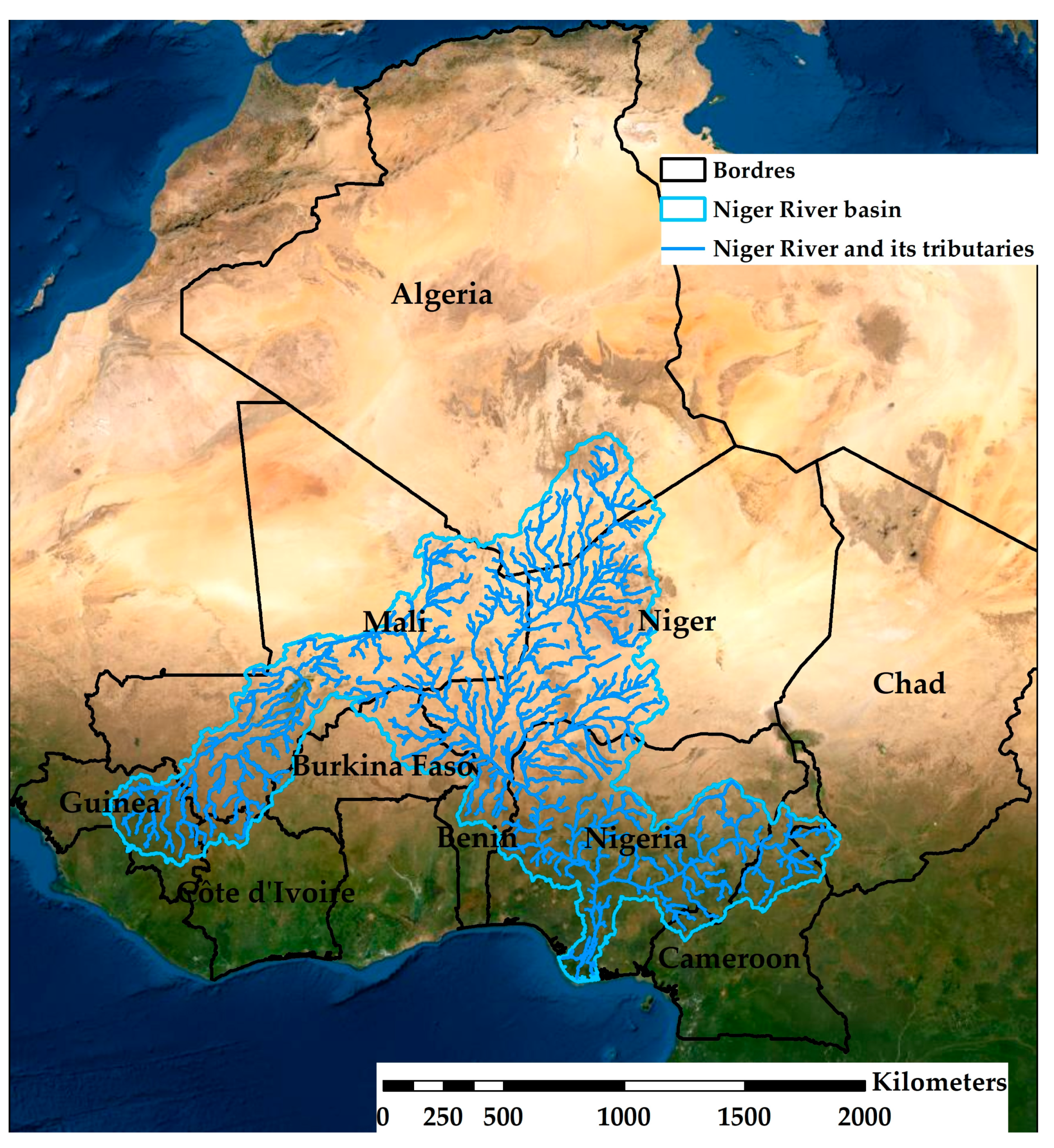
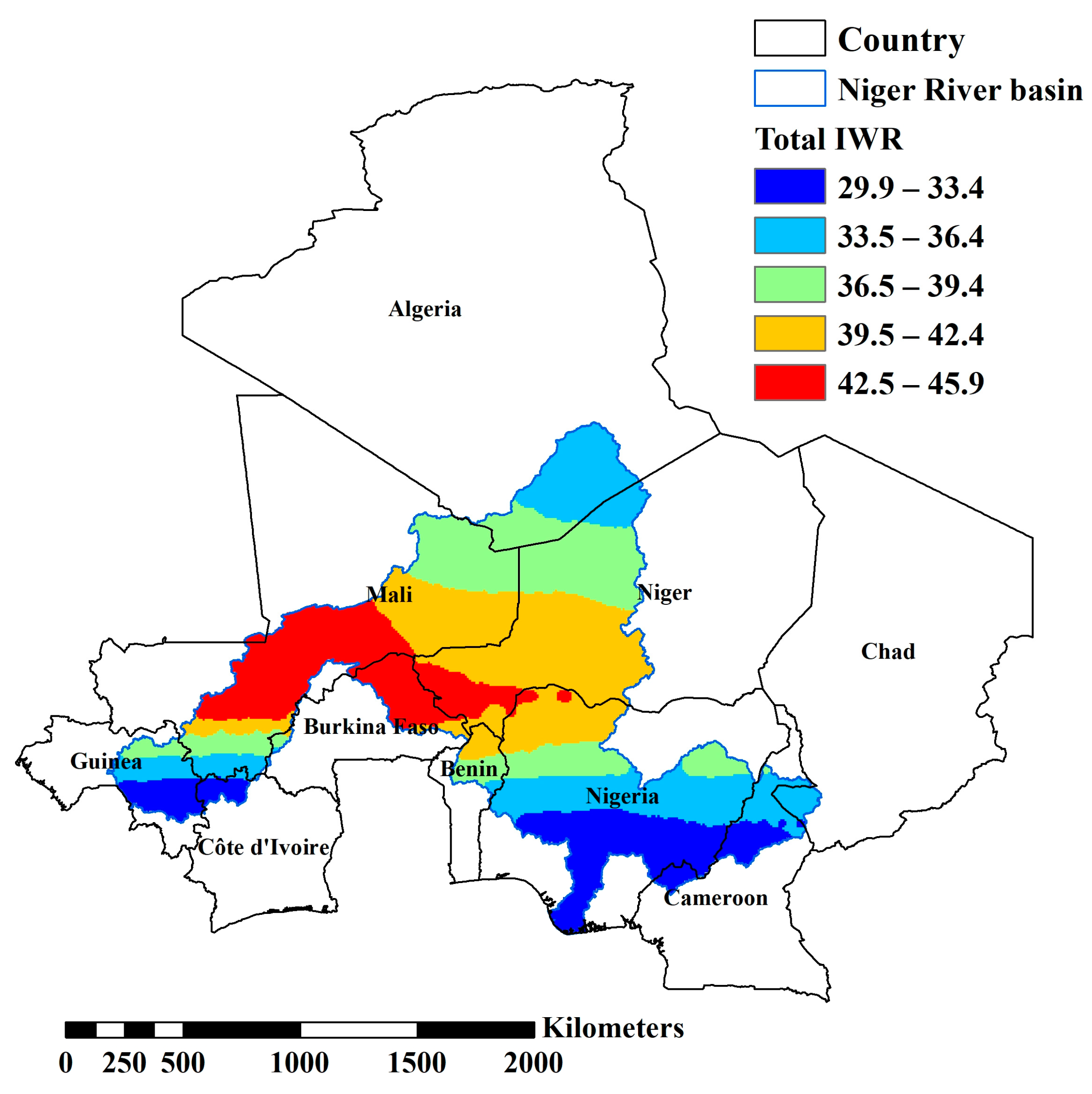
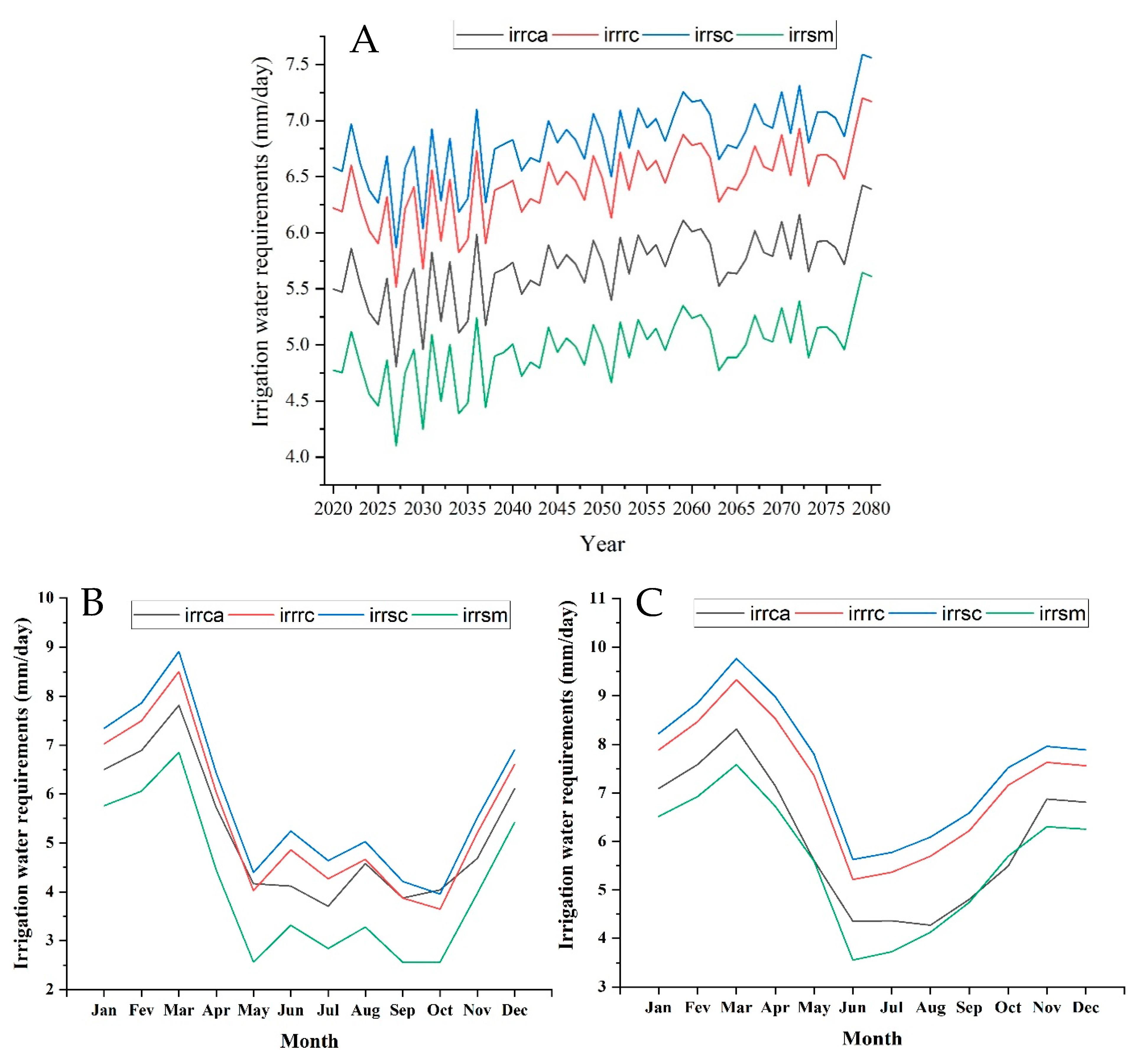
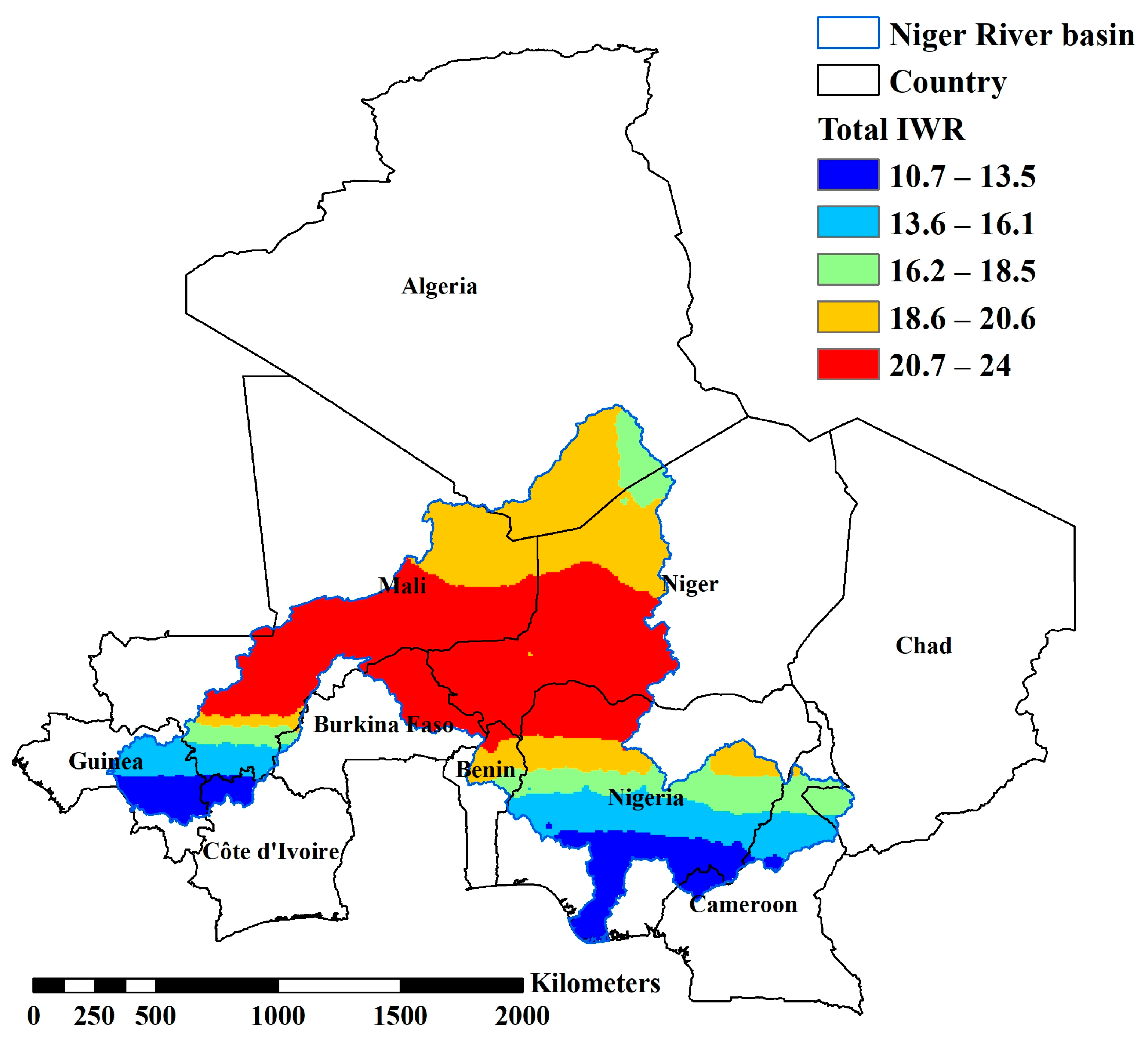
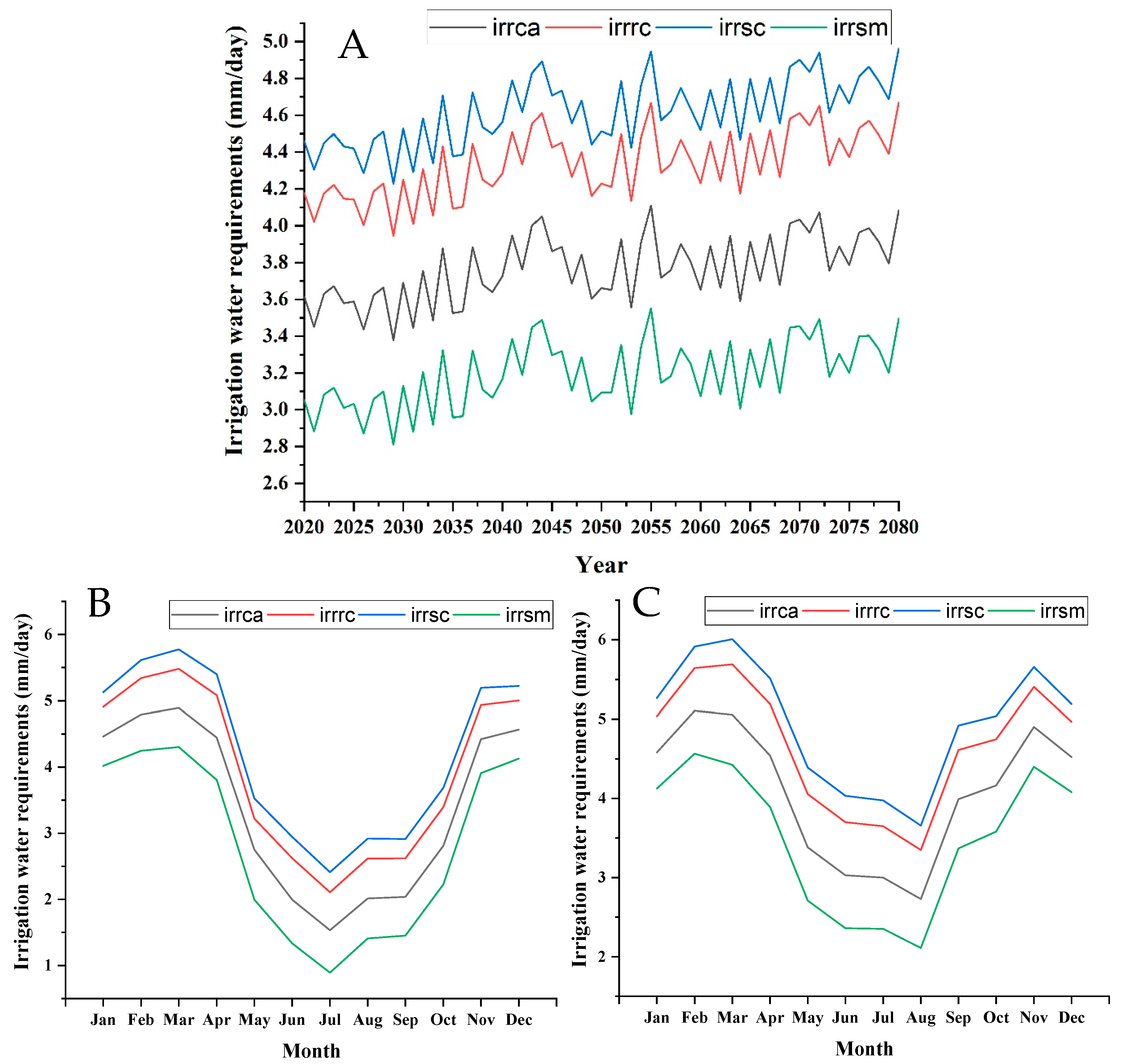

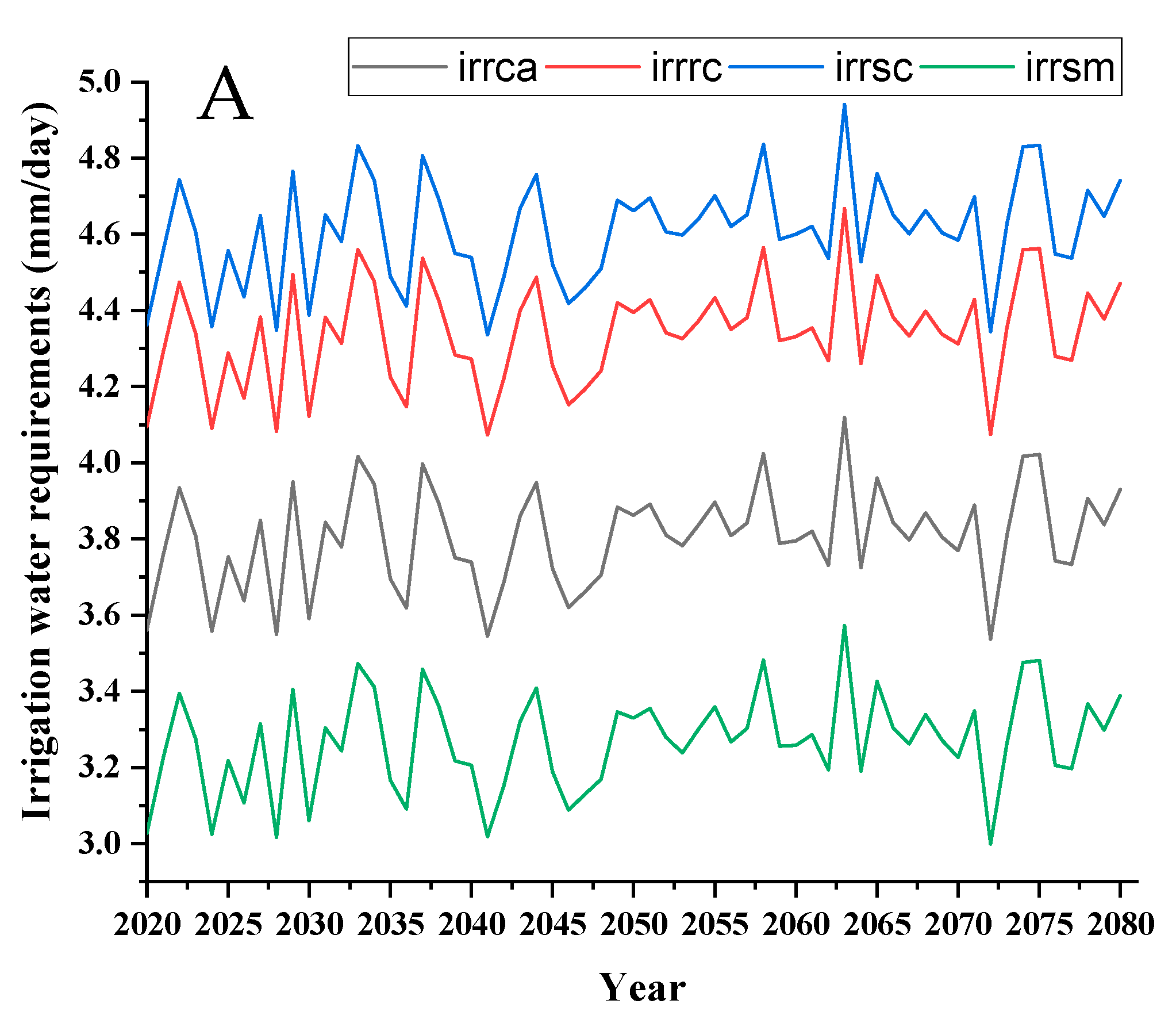
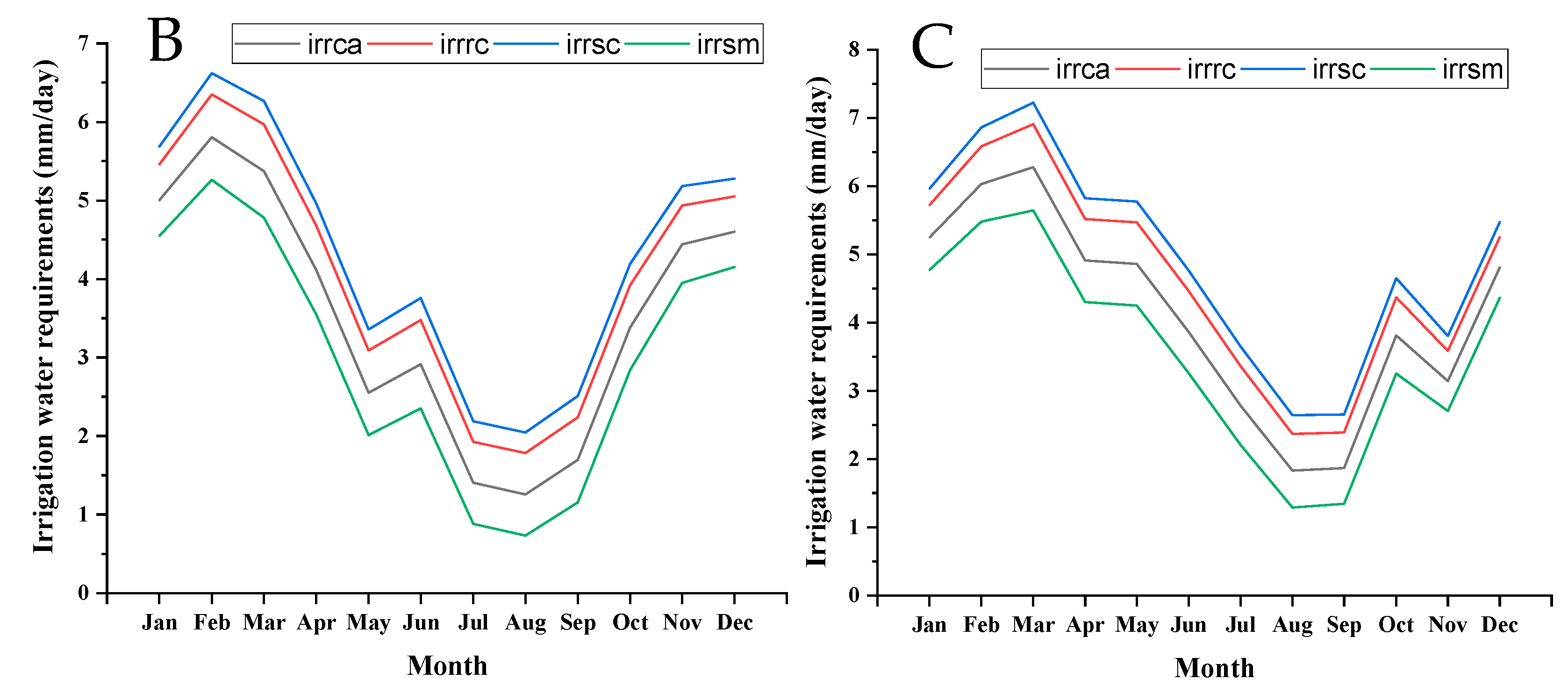
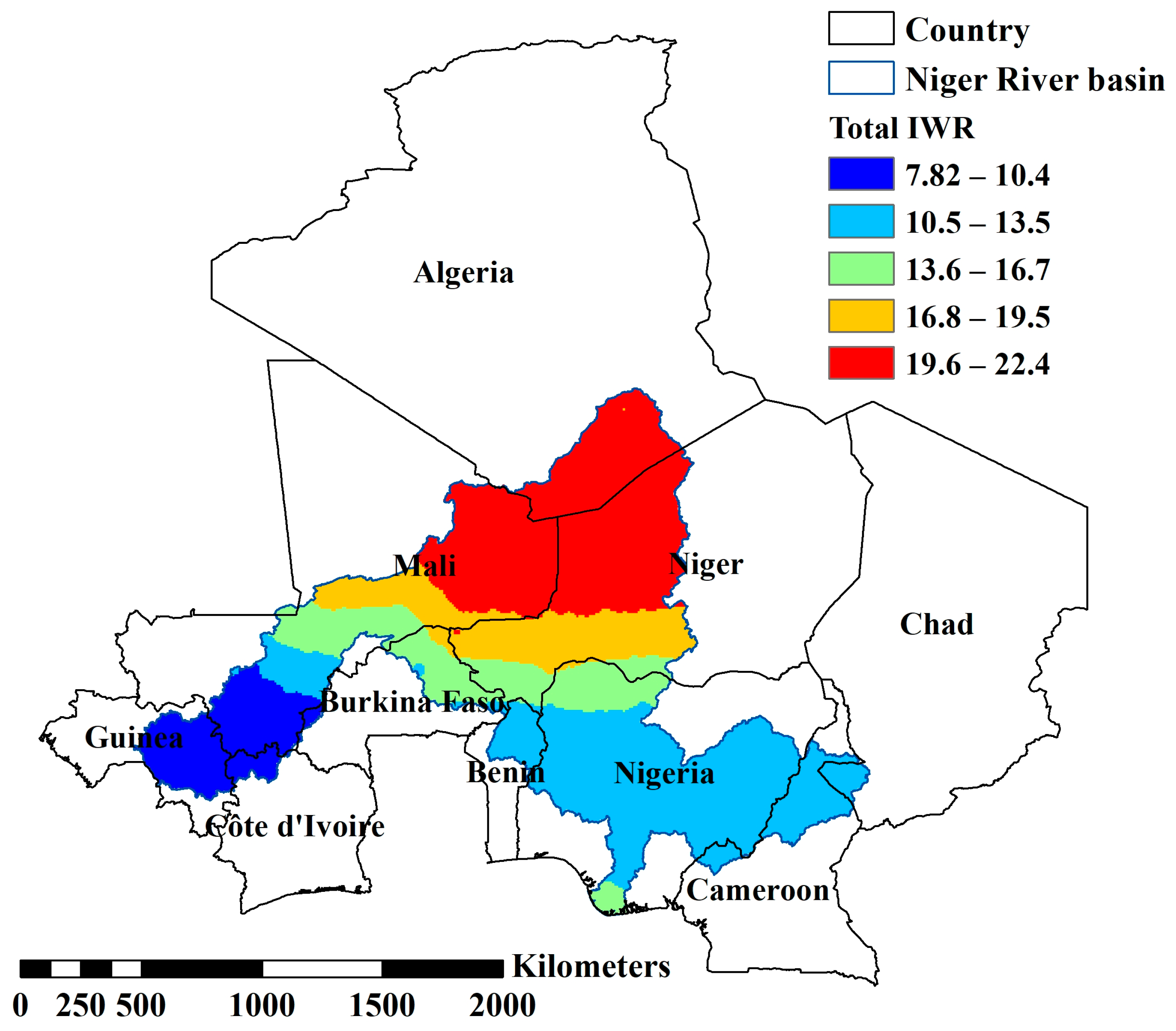
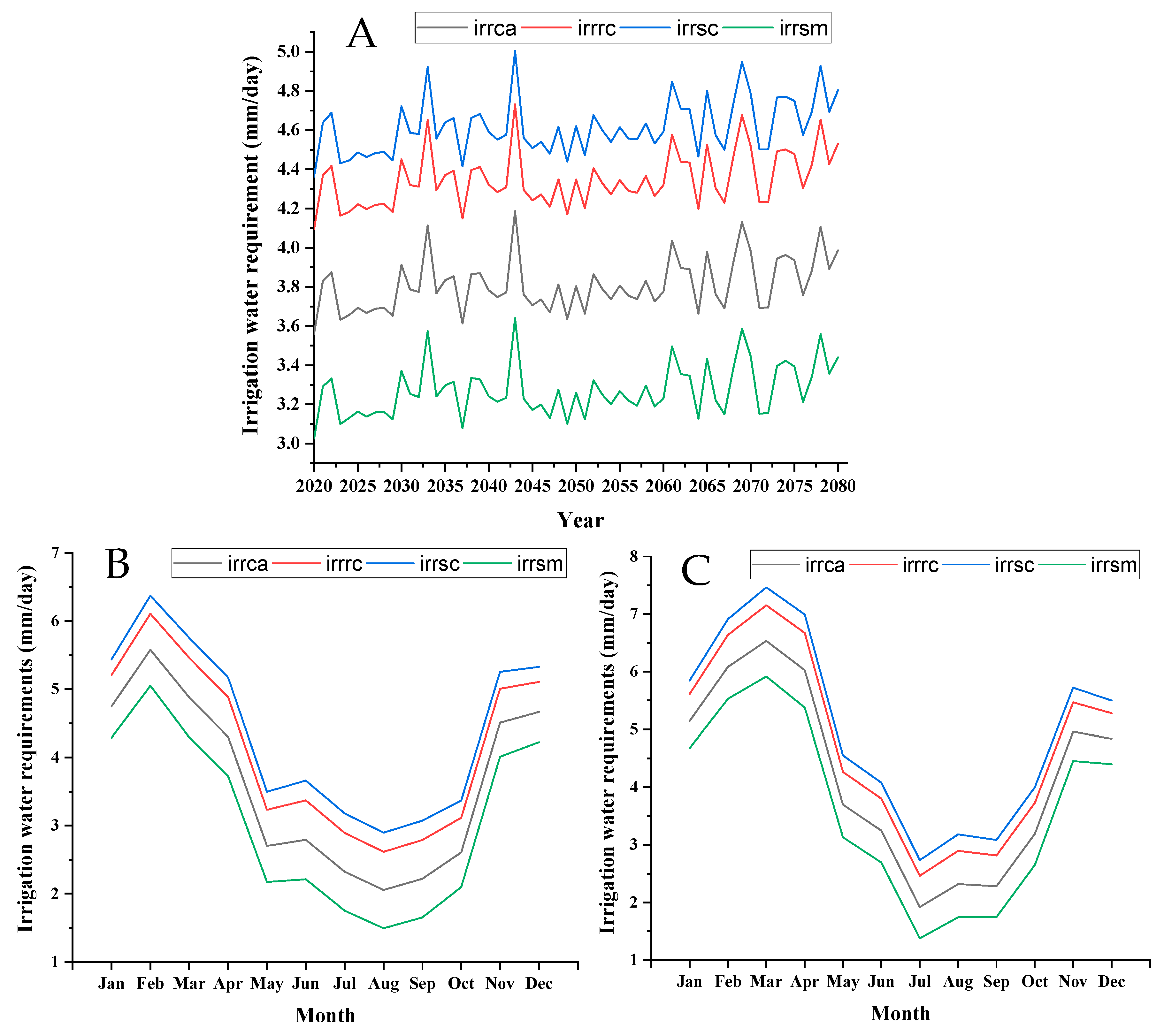
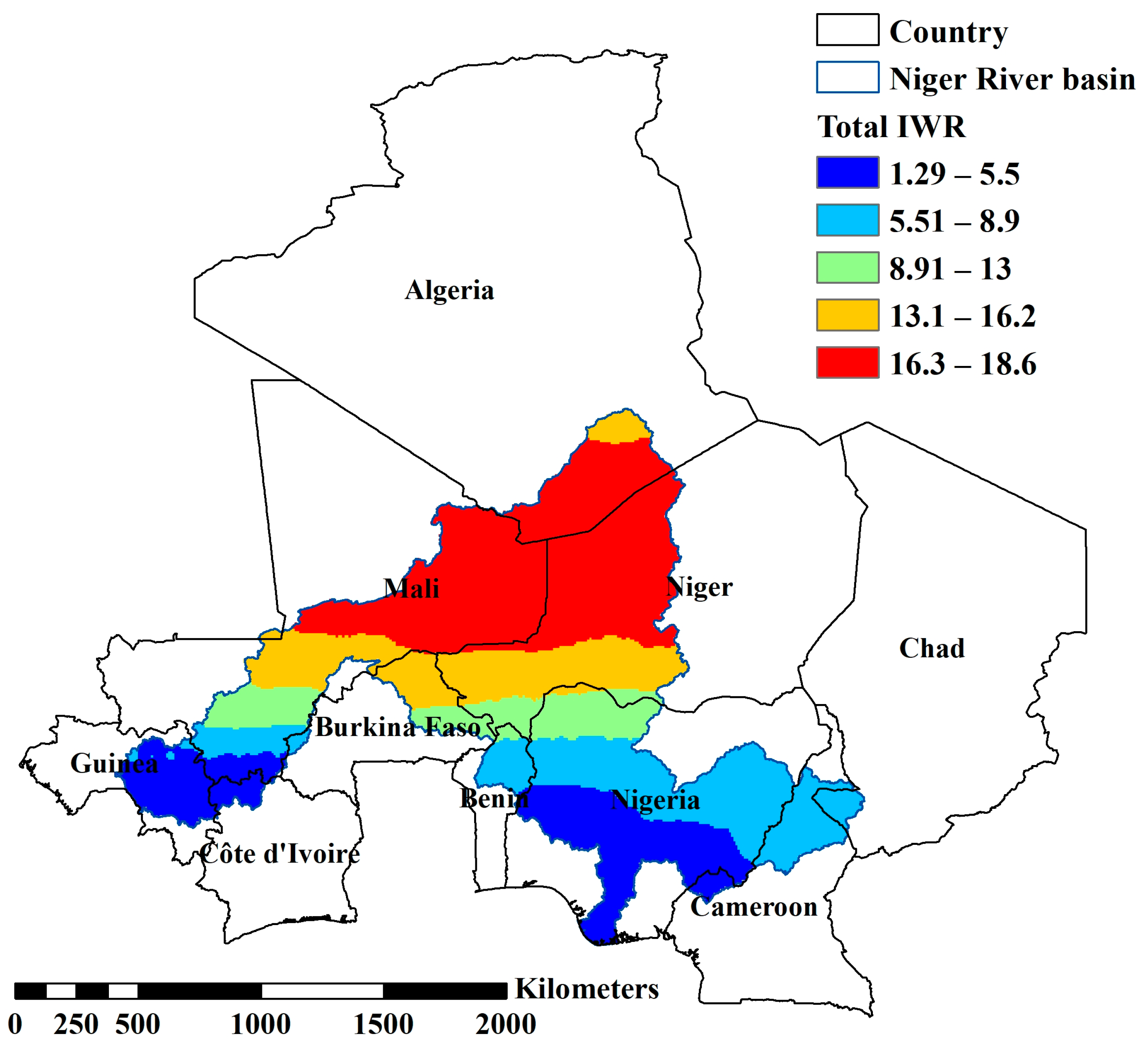
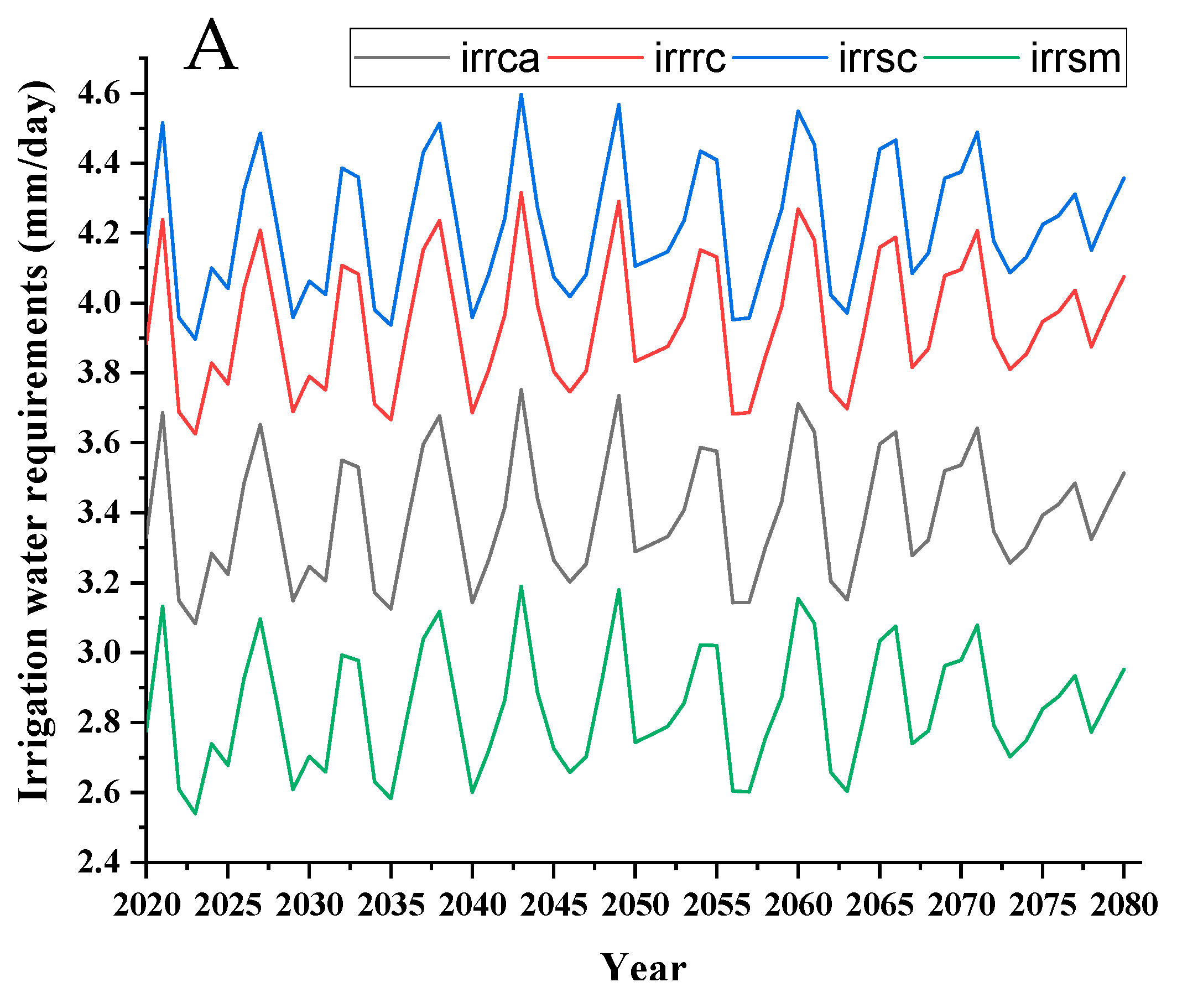
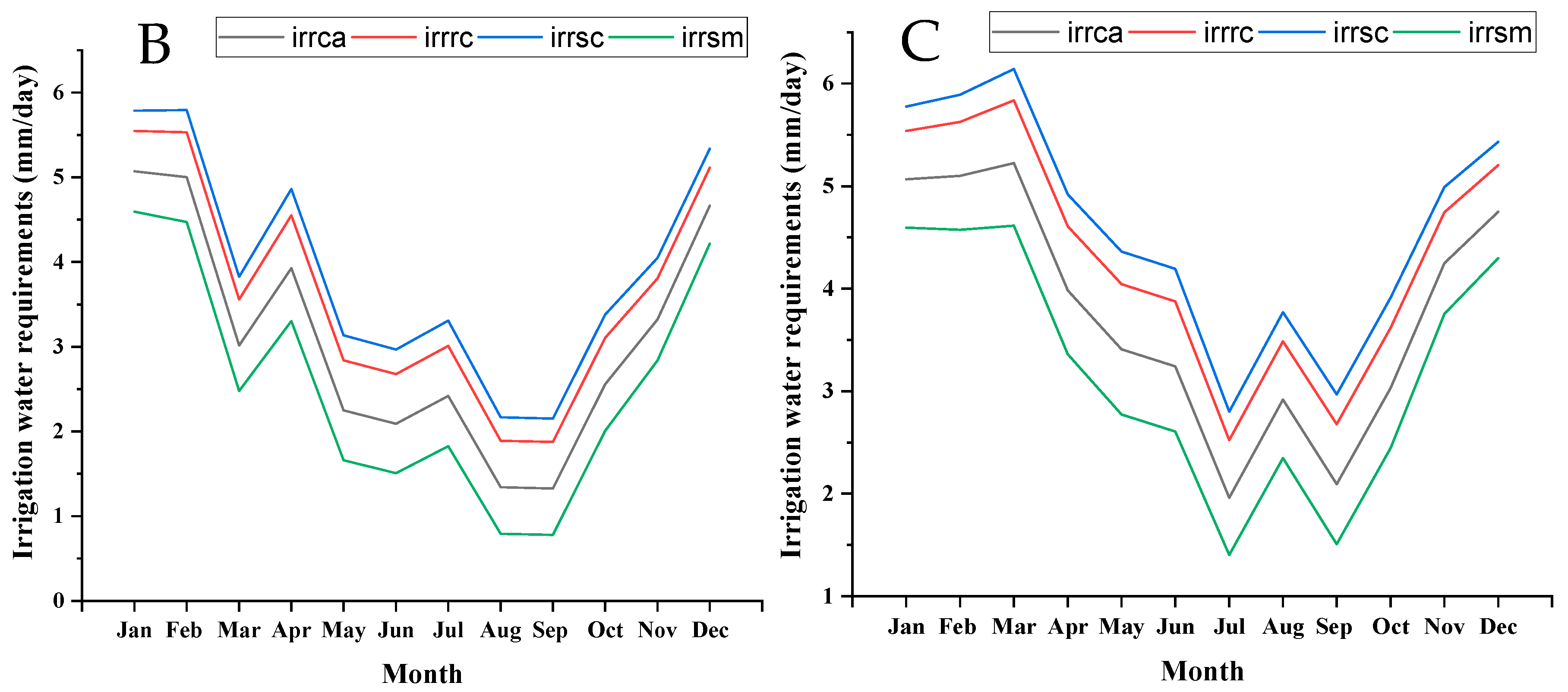


| Country | Year 2020–2040 | |||||||
|---|---|---|---|---|---|---|---|---|
| RCP 4.5 | RCP 8.5 | |||||||
| Irrca | Irrrc | Irrsc | Irrsm | Irrca | Irrrc | Irrsc | Irrsm | |
| BEN | 8.72 | 9.73 | 10.24 | 7.70 | 4.49 | 4.86 | 5.43 | 3.87 |
| BFA | 9.57 | 10.54 | 11.03 | 8.59 | 5.06 | 5.57 | 5.91 | 4.48 |
| CIV | 7.17 | 8.18 | 8.69 | 6.16 | 2.94 | 3.32 | 3.87 | 2.32 |
| CMR | 7.33 | 8.36 | 8.87 | 6.31 | 3.25 | 3.82 | 4.23 | 2.59 |
| DZA | 7.89 | 8.71 | 9.12 | 7.07 | 4.29 | 4.78 | 5.04 | 3.79 |
| GIN | 7.81 | 8.84 | 9.35 | 6.78 | 3.23 | 3.72 | 4.16 | 2.61 |
| MLI | 9.16 | 10.10 | 10.57 | 8.22 | 4.83 | 5.31 | 5.65 | 4.28 |
| NER | 8.84 | 9.72 | 10.15 | 7.96 | 4.76 | 5.28 | 5.52 | 4.25 |
| NGA | 7.86 | 8.87 | 9.37 | 6.84 | 3.68 | 4.22 | 4.63 | 3.04 |
| TCD | 7.74 | 8.77 | 9.29 | 6.70 | 3.69 | 4.26 | 4.69 | 3.02 |
| Year 2040–2060 | ||||||||
| BEN | 9.03 | 10.38 | 10.60 | 7.96 | 4.60 | 5.24 | 5.57 | 3.95 |
| BFA | 10.05 | 11.19 | 11.60 | 9.01 | 5.26 | 5.87 | 6.17 | 4.65 |
| CIV | 7.44 | 8.99 | 9.05 | 6.42 | 2.78 | 3.41 | 3.73 | 2.15 |
| CMR | 7.56 | 8.75 | 9.14 | 6.51 | 3.57 | 4.23 | 4.57 | 2.90 |
| DZA | 8.39 | 9.26 | 9.69 | 7.51 | 4.52 | 5.04 | 5.30 | 4.00 |
| GIN | 7.95 | 9.25 | 9.55 | 6.89 | 2.95 | 3.58 | 3.90 | 2.32 |
| MLI | 9.67 | 10.72 | 11.17 | 8.67 | 4.96 | 5.54 | 5.83 | 4.38 |
| NER | 9.48 | 10.40 | 10.89 | 8.54 | 5.09 | 5.64 | 5.91 | 4.54 |
| NGA | 8.18 | 9.34 | 9.75 | 7.13 | 3.96 | 4.61 | 4.94 | 3.30 |
| TCD | 7.92 | 9.04 | 9.48 | 6.84 | 4.01 | 4.69 | 5.03 | 3.33 |
| Year 2060–2080 | ||||||||
| BEN | 4.49 | 5.10 | 11.12 | 8.26 | 4.70 | 5.37 | 5.70 | 3.84 |
| BFA | 5.43 | 6.11 | 11.95 | 9.24 | 5.32 | 5.94 | 6.26 | 4.65 |
| CIV | 4.10 | 4.70 | 9.61 | 6.64 | 2.80 | 3.44 | 3.76 | 1.97 |
| CMR | 3.52 | 4.10 | 9.59 | 6.82 | 3.61 | 4.29 | 4.62 | 2.84 |
| DZA | 9.43 | 10.32 | 9.96 | 7.72 | 4.79 | 5.33 | 5.60 | 4.22 |
| GIN | 4.59 | 5.23 | 9.86 | 6.99 | 3.00 | 3.64 | 3.96 | 2.27 |
| MLI | 8.31 | 9.15 | 11.47 | 8.89 | 5.09 | 5.69 | 5.99 | 4.44 |
| NER | 9.14 | 10.03 | 11.10 | 8.72 | 5.25 | 5.82 | 6.10 | 4.68 |
| NGA | 4.57 | 5.19 | 10.13 | 7.38 | 4.06 | 4.73 | 5.06 | 3.31 |
| TCD | 8.81 | 9.68 | 9.90 | 7.17 | 4.09 | 4.78 | 5.12 | 3.30 |
| Country | Year 2020–2040 | |||||||
|---|---|---|---|---|---|---|---|---|
| RCP 4.5 | RCP 8.5 | |||||||
| Irrca | Irrrc | Irrsc | Irrsm | Irrca | Irrrc | Irrsc | Irrsm | |
| BEN | 2.80 | 3.42 | 3.74 | 2.17 | 2.64 | 3.27 | 3.58 | 2.01 |
| BFA | 3.49 | 4.11 | 4.42 | 2.87 | 3.35 | 3.97 | 4.28 | 2.74 |
| CIV | 1.91 | 2.51 | 2.81 | 1.31 | 1.86 | 2.47 | 2.77 | 1.25 |
| CMR | 2.62 | 3.25 | 3.56 | 1.99 | 2.61 | 3.24 | 3.55 | 1.98 |
| DZA | 4.88 | 5.43 | 5.70 | 4.33 | 4.83 | 5.37 | 5.65 | 4.28 |
| GIN | 1.85 | 2.45 | 2.76 | 1.25 | 1.77 | 2.38 | 2.68 | 1.17 |
| MLI | 3.84 | 4.44 | 4.74 | 3.24 | 3.86 | 4.46 | 4.76 | 3.26 |
| NER | 4.70 | 5.30 | 5.60 | 4.10 | 4.57 | 5.17 | 5.47 | 3.97 |
| NGA | 2.79 | 3.42 | 3.73 | 2.17 | 2.69 | 3.32 | 3.63 | 2.06 |
| TCD | 2.63 | 3.25 | 3.57 | 2.00 | 2.59 | 3.22 | 3.54 | 1.96 |
| Year 2040–2060 | ||||||||
| BEN | 2.71 | 3.34 | 3.65 | 2.09 | 2.67 | 3.30 | 3.62 | 2.04 |
| BFA | 3.50 | 4.12 | 4.43 | 2.87 | 3.34 | 3.96 | 4.28 | 2.71 |
| CIV | 2.05 | 2.66 | 2.97 | 1.44 | 2.13 | 2.74 | 3.05 | 1.51 |
| CMR | 2.78 | 3.42 | 3.74 | 2.15 | 2.86 | 3.49 | 3.81 | 2.22 |
| DZA | 4.83 | 5.38 | 5.65 | 4.28 | 4.88 | 5.43 | 5.70 | 4.33 |
| GIN | 1.96 | 2.57 | 2.87 | 1.35 | 2.02 | 2.63 | 2.94 | 1.40 |
| MLI | 3.92 | 4.53 | 4.83 | 3.32 | 3.78 | 4.39 | 4.69 | 3.17 |
| NER | 4.70 | 5.31 | 5.61 | 4.10 | 4.59 | 5.20 | 5.50 | 3.98 |
| NGA | 2.85 | 3.48 | 3.80 | 2.22 | 2.87 | 3.50 | 3.82 | 2.23 |
| TCD | 2.78 | 3.41 | 3.73 | 2.15 | 2.87 | 3.50 | 3.82 | 2.23 |
| Year 2060–2080 | ||||||||
| BEN | 2.65 | 3.27 | 3.59 | 2.10 | 2.74 | 3.38 | 3.70 | 2.10 |
| BFA | 3.41 | 4.04 | 4.35 | 2.85 | 3.48 | 4.11 | 4.43 | 2.85 |
| CIV | 1.98 | 2.59 | 2.90 | 1.59 | 2.22 | 2.84 | 3.15 | 1.59 |
| CMR | 2.78 | 3.41 | 3.73 | 2.41 | 3.06 | 3.71 | 4.03 | 2.41 |
| DZA | 4.79 | 5.33 | 5.61 | 4.57 | 5.13 | 5.69 | 5.97 | 4.57 |
| GIN | 1.91 | 2.52 | 2.83 | 1.53 | 2.15 | 2.77 | 3.08 | 1.53 |
| MLI | 3.84 | 4.45 | 4.75 | 3.40 | 4.02 | 4.64 | 4.95 | 3.41 |
| NER | 4.63 | 5.23 | 5.54 | 4.13 | 4.74 | 5.36 | 5.67 | 4.13 |
| NGA | 2.77 | 3.40 | 3.72 | 2.33 | 2.97 | 3.62 | 3.94 | 2.33 |
| TCD | 2.78 | 3.42 | 3.74 | 2.42 | 3.07 | 3.72 | 4.05 | 2.42 |
| Country | Year 2020–2040 | |||||||
|---|---|---|---|---|---|---|---|---|
| RCP 4.5 | RCP 8.5 | |||||||
| Irrca | Irrrc | Irrsc | Irrsm | Irrca | Irrrc | Irrsc | Irrsm | |
| BEN | 0.22 | 0.24 | 0.25 | 0.20 | 18.90 | 20.94 | 21.96 | 16.86 |
| BFA | 0.23 | 0.25 | 0.26 | 0.21 | 17.71 | 19.65 | 20.63 | 15.76 |
| CIV | 0.23 | 0.25 | 0.26 | 0.21 | 17.32 | 19.36 | 20.37 | 15.29 |
| CMR | 0.23 | 0.25 | 0.26 | 0.21 | 20.94 | 23.49 | 24.77 | 18.40 |
| DZA | 0.25 | 0.27 | 0.28 | 0.22 | 20.03 | 22.44 | 23.65 | 17.63 |
| GIN | 0.23 | 0.25 | 0.26 | 0.21 | 17.22 | 19.23 | 20.23 | 15.21 |
| MLI | 0.23 | 0.25 | 0.27 | 0.21 | 17.46 | 19.47 | 20.48 | 15.45 |
| NER | 0.23 | 0.25 | 0.26 | 0.21 | 18.08 | 20.11 | 21.12 | 16.05 |
| NGA | 0.23 | 0.25 | 0.26 | 0.20 | 20.06 | 22.36 | 23.52 | 17.75 |
| TCD | 0.23 | 0.25 | 0.26 | 0.21 | 21.44 | 23.91 | 25.14 | 18.97 |
| Year 2040–2060 | ||||||||
| BEN | 0.22 | 0.25 | 0.26 | 0.20 | 18.95 | 20.99 | 22.01 | 16.90 |
| BFA | 0.23 | 0.25 | 0.26 | 0.21 | 17.98 | 19.92 | 20.90 | 16.03 |
| CIV | 0.23 | 0.25 | 0.26 | 0.21 | 17.53 | 19.57 | 20.59 | 15.49 |
| CMR | 0.24 | 0.26 | 0.27 | 0.21 | 20.85 | 23.41 | 24.69 | 18.29 |
| DZA | 0.25 | 0.27 | 0.28 | 0.23 | 20.54 | 22.94 | 24.16 | 18.07 |
| GIN | 0.23 | 0.25 | 0.26 | 0.21 | 17.48 | 19.50 | 20.51 | 15.46 |
| MLI | 0.24 | 0.26 | 0.27 | 0.22 | 17.87 | 19.90 | 20.91 | 15.85 |
| NER | 0.24 | 0.26 | 0.27 | 0.21 | 18.44 | 20.48 | 21.50 | 16.40 |
| NGA | 0.23 | 0.25 | 0.26 | 0.21 | 19.89 | 22.21 | 23.36 | 17.60 |
| TCD | 0.23 | 0.25 | 0.26 | 0.21 | 21.41 | 23.90 | 25.14 | 18.95 |
| Year 2060–2080 | ||||||||
| BEN | 0.23 | 0.25 | 0.26 | 0.21 | 19.00 | 21.05 | 22.08 | 16.96 |
| BFA | 0.23 | 0.25 | 0.26 | 0.21 | 18.36 | 20.32 | 21.30 | 16.40 |
| CIV | 0.23 | 0.25 | 0.27 | 0.21 | 17.74 | 19.79 | 20.82 | 15.70 |
| CMR | 0.24 | 0.26 | 0.27 | 0.22 | 21.29 | 23.88 | 25.17 | 18.70 |
| DZA | 0.25 | 0.28 | 0.29 | 0.23 | 21.12 | 23.59 | 24.82 | 18.66 |
| GIN | 0.24 | 0.26 | 0.27 | 0.21 | 17.80 | 19.83 | 20.84 | 15.76 |
| MLI | 0.24 | 0.26 | 0.27 | 0.22 | 18.38 | 20.43 | 21.45 | 16.34 |
| NER | 0.24 | 0.26 | 0.27 | 0.22 | 18.80 | 20.85 | 21.87 | 16.75 |
| NGA | 0.23 | 0.25 | 0.26 | 0.21 | 20.22 | 22.56 | 23.72 | 17.89 |
| TCD | 0.23 | 0.25 | 0.27 | 0.21 | 21.88 | 24.40 | 25.66 | 19.37 |
Publisher’s Note: MDPI stays neutral with regard to jurisdictional claims in published maps and institutional affiliations. |
© 2021 by the authors. Licensee MDPI, Basel, Switzerland. This article is an open access article distributed under the terms and conditions of the Creative Commons Attribution (CC BY) license (http://creativecommons.org/licenses/by/4.0/).
Share and Cite
Abdoulaye, A.O.; Lu, H.; Zhu, Y.; Hamoud, Y.A. Future Irrigation Water Requirements of the Main Crops Cultivated in the Niger River Basin. Atmosphere 2021, 12, 439. https://doi.org/10.3390/atmos12040439
Abdoulaye AO, Lu H, Zhu Y, Hamoud YA. Future Irrigation Water Requirements of the Main Crops Cultivated in the Niger River Basin. Atmosphere. 2021; 12(4):439. https://doi.org/10.3390/atmos12040439
Chicago/Turabian StyleAbdoulaye, Abdoulaye Oumarou, Haishen Lu, Yonghua Zhu, and Yousef Alhaj Hamoud. 2021. "Future Irrigation Water Requirements of the Main Crops Cultivated in the Niger River Basin" Atmosphere 12, no. 4: 439. https://doi.org/10.3390/atmos12040439
APA StyleAbdoulaye, A. O., Lu, H., Zhu, Y., & Hamoud, Y. A. (2021). Future Irrigation Water Requirements of the Main Crops Cultivated in the Niger River Basin. Atmosphere, 12(4), 439. https://doi.org/10.3390/atmos12040439







